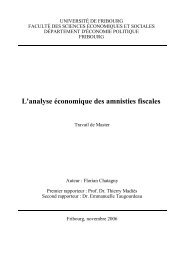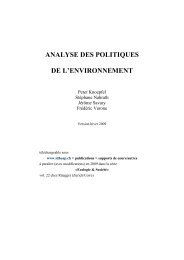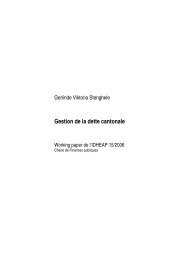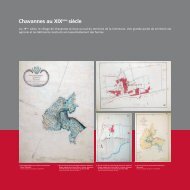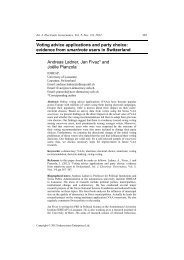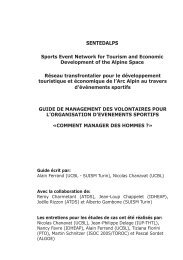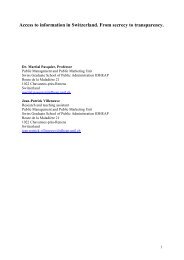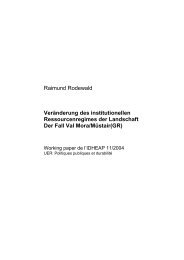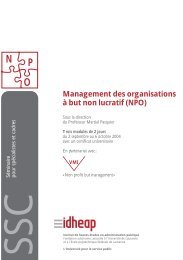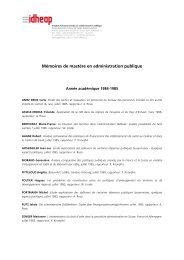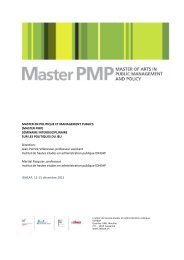Historical Analysis of Institutional Regimes in Switzerland ... - IDHEAP
Historical Analysis of Institutional Regimes in Switzerland ... - IDHEAP
Historical Analysis of Institutional Regimes in Switzerland ... - IDHEAP
You also want an ePaper? Increase the reach of your titles
YUMPU automatically turns print PDFs into web optimized ePapers that Google loves.
6<br />
3. Target groups are social actors whose behaviour is considered by the protection or use<br />
policy as relevant to the resolution <strong>of</strong> the problem <strong>in</strong> question. State <strong>in</strong>tervention is <strong>in</strong>tended<br />
to transform or stabilise this target-group behaviour <strong>in</strong> order to achieve the desired aims.<br />
4. <strong>Institutional</strong> arrangements def<strong>in</strong>e the authorities and <strong>of</strong>fices responsible for the<br />
implementation <strong>of</strong> <strong>in</strong>struments. In addition to this area <strong>of</strong> competence, they are also charged<br />
with decisions concern<strong>in</strong>g the public resources (e.g. money, <strong>in</strong>frastructure, personnel, time,<br />
<strong>in</strong>formation, consensus) at the disposal <strong>of</strong> the identified implement<strong>in</strong>g actors.<br />
5. In order to realise the desired effects, each policy design is based on a rationale, which<br />
comprises hypotheses on the effect structure beh<strong>in</strong>d the collective problem and the possible<br />
forms <strong>of</strong> state action. The causal hypothesis responds to the question as to who or what is<br />
to blame or is objectively responsible for the unacceptable use <strong>of</strong> the resource. This gives<br />
rise to the political def<strong>in</strong>ition <strong>of</strong> the target group <strong>in</strong> the policy design. The <strong>in</strong>tervention<br />
hypothesis responds to the question as to how the behaviour <strong>of</strong> the target groups can be<br />
<strong>in</strong>fluenced <strong>in</strong> such a way as to achieve the def<strong>in</strong>ed aims<br />
Policy analysis shows that such policy designs are <strong>of</strong>ten <strong>in</strong>complete or <strong>in</strong>coherent, that they are only<br />
partly implemented and/or that the effects achieved only partly correspond to the def<strong>in</strong>ed aims. Thus,<br />
it is imperative to exam<strong>in</strong>e the extent to which the concrete use and management <strong>of</strong> a natural<br />
resource depends on the <strong>in</strong>ternal coherence and degree <strong>of</strong> implementation <strong>of</strong> such policy designs.<br />
b) The limits <strong>of</strong> the policy approach<br />
Like the <strong>in</strong>stitutional economics approach to resource use and management, policy analysis has also<br />
some shortcom<strong>in</strong>gs which are described below:<br />
• By focus<strong>in</strong>g ma<strong>in</strong>ly on policy implementation the traditional policy analysis has an<br />
<strong>in</strong>herent “conservatism bias”. There is a need to question the <strong>in</strong>ternal coherence <strong>of</strong><br />
policy design <strong>in</strong> order to anticipate foreseeable policy failures and to propose<br />
<strong>in</strong>novative and effective IR.<br />
As policy analysis ma<strong>in</strong>ly focuses on the implementation <strong>of</strong> exist<strong>in</strong>g policies, it is (at least potentially)<br />
somewhat conservative. It may try to improve the implementation <strong>of</strong> exist<strong>in</strong>g policies<br />
marg<strong>in</strong>ally/<strong>in</strong>crementally with its empirical-analytical conclusions and prescriptive recommendations<br />
(e.g. adaptation <strong>of</strong> an <strong>in</strong>strument, extension <strong>of</strong> the implementation arrangement) but it does not really<br />
question the policy design and action logic beh<strong>in</strong>d them. The ex ante analysis <strong>of</strong> the coherence <strong>of</strong><br />
certa<strong>in</strong> policy designs demonstrates, however, that <strong>in</strong> many cases, implementation deficits and<br />
undesired policy effects are or could be completely predictable from the outset. To take this <strong>in</strong>to<br />
account, policy analysis should also systematically exam<strong>in</strong>e the causal and <strong>in</strong>tervention hypotheses <strong>of</strong><br />
a public policy.<br />
• “Resource-protection” policies which are normally <strong>in</strong>vestigated by the traditional<br />
policy analysis concern only one aspect <strong>of</strong> susta<strong>in</strong>ability and <strong>in</strong>tegrated resource<br />
management.<br />
Environmental policies are generally conceived to protect a natural resource (or one or more parts<br />
there<strong>of</strong>). The concept <strong>of</strong> susta<strong>in</strong>ability is ultimately concerned with tak<strong>in</strong>g <strong>in</strong>to account, comb<strong>in</strong><strong>in</strong>g<br />
and adjust<strong>in</strong>g both protection and use measures. A comprehensive analysis <strong>of</strong> the public policies,<br />
which together <strong>in</strong>fluence the susta<strong>in</strong>ability <strong>of</strong> a natural resource, should, therefore, also <strong>in</strong>clude



